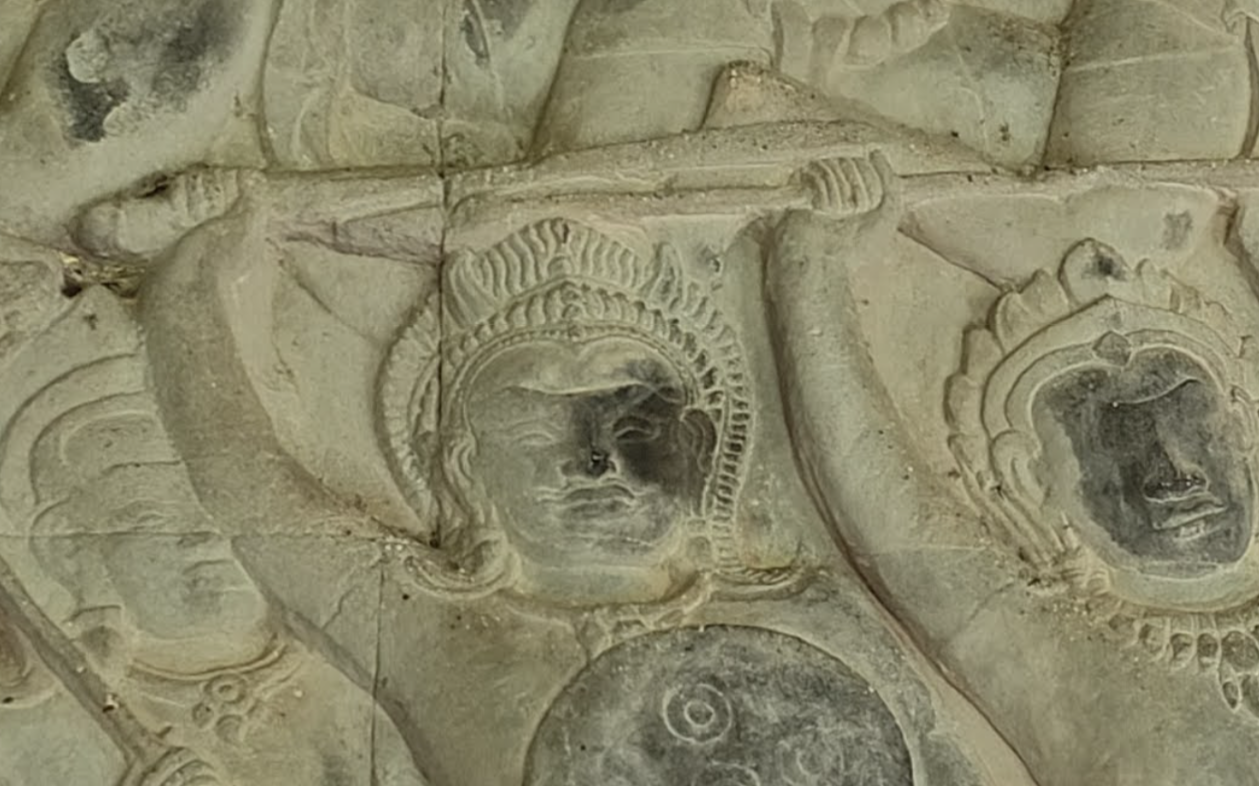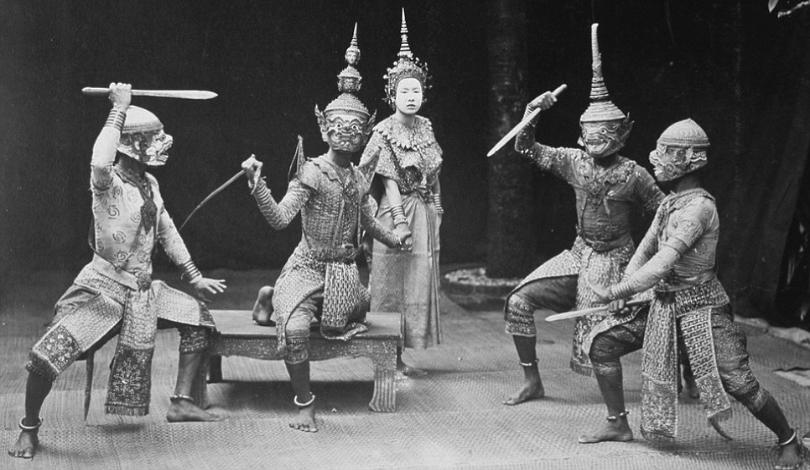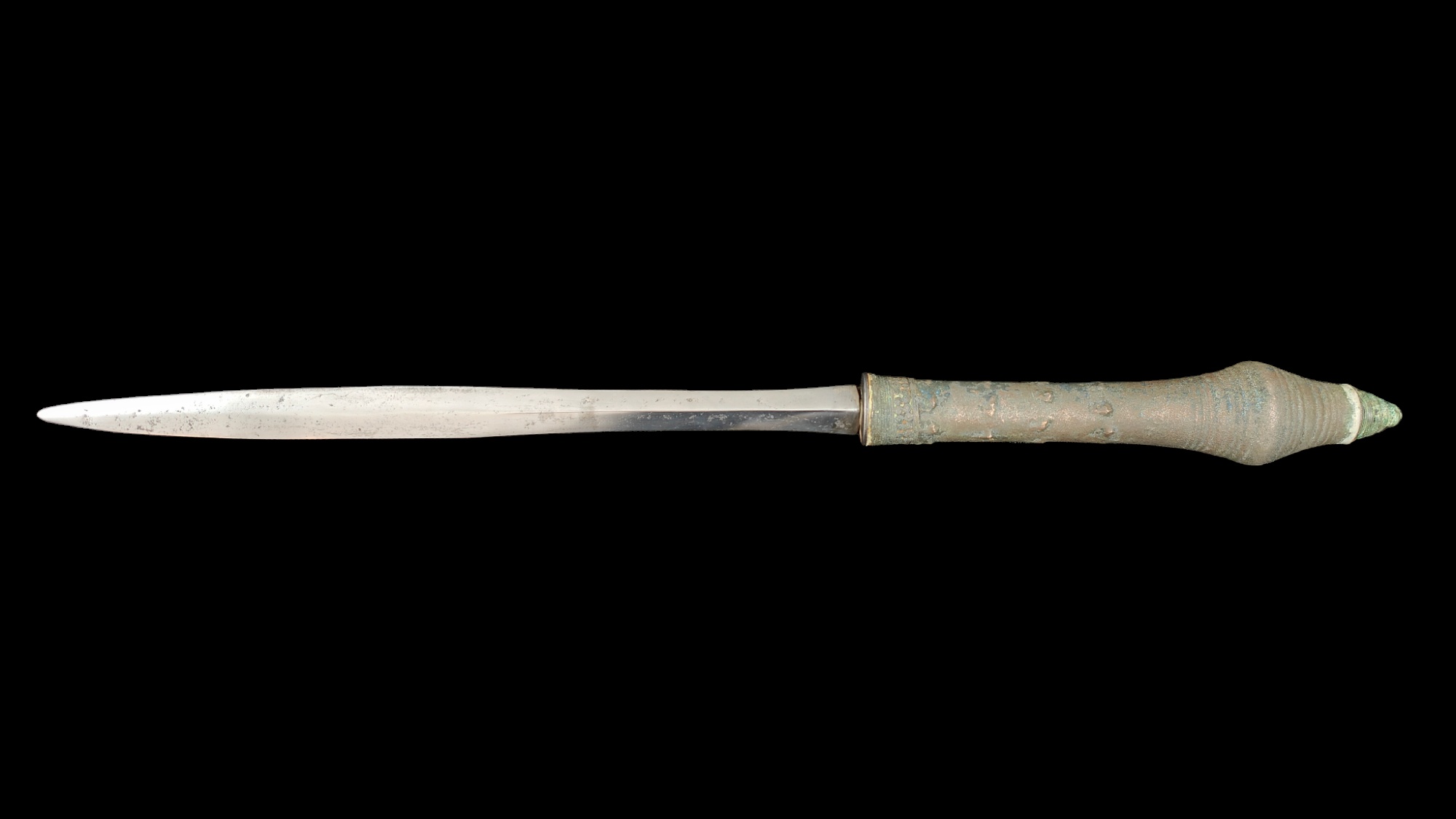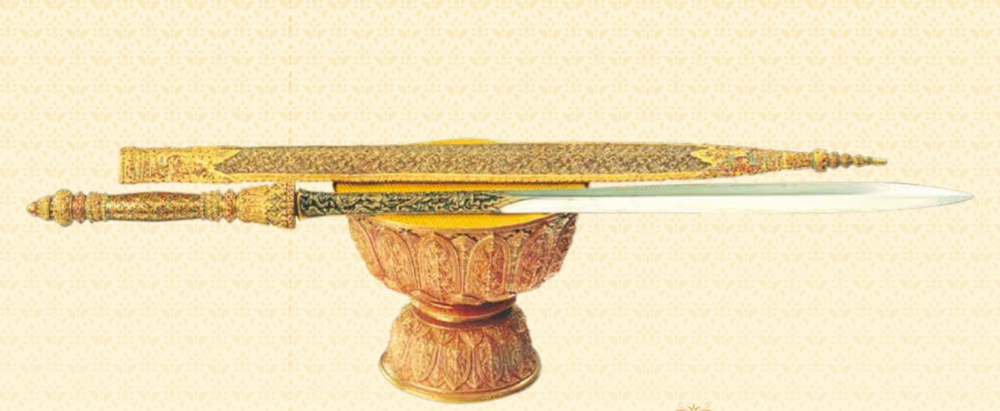
Preah Khan - Ceremony, Royalty and Swords
October 11, 2023 Asian Arms
The Preah Khan is a 12th century temple complex at Angkor. Translated as "Royal Sword" it was built by Jayavarman VII in the 12th century. It is an early example of the importance of the sword in Khmer culture and in particular its relationship to royalty and ceremony. The temple site is situated on the ground of a significant battle between the Khmer and Cham, where the Khmer emerged victorious. The Preah Khan Reach itself is the legendary royal sword of the Khmer kings and was a symbol of power and the legitimacy of the ruler. The earliest period where the sword is mentioned is the transfer of power between Jayavarman II and Jayavarman III in the mid 9th century. Whether this sword was in fact the same as the one that was last seen in the 20th century cannot be stated with any certainty. What can be said however, is that the history of, the Preah Khan Reach is filled with tragedy, with the sword being lost at various times, including being held in Siam for some time, with the Siamese royal sword according to some accounts being modelled on the Khmer sword, while other accounts attribute it much further back to Sukhothai. There also exist legends among the Jurai regarding a sacred sword which may relate to a period when the sword was secreted in the mountains among these people.
Background
The sword was kept by court Brahmins and according to research and interviews carried out by Martine Piat in the 20th century, the Brahmins referenced in fact four royal swords, the whereabouts of which are unknown. Court Brahimns are a reflection of the Indic influences on Khmer civilisation and are echoed to the current day in Thailand, where they are also charged with royal ceremonies and are caretakers of the Phra Saeng Khan Chai Sri, the royal Thai sword. These swords, both the Khmer and Siamese examples, are of a similar pattern, being doubled edged with single handed grips, large pommels and somewhat leaf shaped blades. This is of course entirely different to the ubiquitous sabre, the dha, common to these regions and also differs from other ancient Khmer swords and sabres depicted at sites from the Angkor period.

Base relief from the outer wall of the Bayon temple at Angkor Thom (source: alamy.com)
The origins of this design are difficult to ascertain, but similar forms can be observed in Khmer temple reliefs and carvings and perhaps share a common history with the Indic influences that shaped much of the early Khmer empire. Little pictorial evidence exists and base reliefs do not typically show explicit detail of blade and hilt forms, but some examples shown below clearly depict short swords with large bulbous pommels, including a depiction of a warrior leaping onto a chariot.
.jpg)
Base relief from the Baphuon temple at Angkor Thom (source: meisterdrucke.ie)

Base relief from the terrace of the Leper King at Angkor Thom (source: voyagevirtuel.co.uk)
An even clearer depiction of the distinct leaf like blade shape can be seen within the main Angkor wat complex and also shows the use of a shield paired with this sword type. This particular gallery and set of reliefs depicts the Battle of Lanka from the great Sanskrit epic, The Ramayana. The warrior wielding this sword is a demon fighting on the side of the evil ruler Ravana. This provides further evidence that this sword style is very old and originates in the early days of the Khmer empire.

Battle of Lanka at Angkor Wat (source: author's photo)
Legendary Origins
The royal swords, both in a Siamese and Khmer context, are items that are layered in legends and often confused origins. The Preah Khan Reach is first mentioned in the mid 9th century (see Briggs, The Ancient Khmer Empire), while the Phra Saeng Khan Chai Si has two main origin stories. The first, which is also stated in a 2006 government publication from the Thai Foreign Office (see Thailand Illustrated volume 23, Issue 3), is that the sword was found in 1784 by a Cambodian fisherman in Tonle Sap and it was then presented by the Cambodian king to Rama I, his suzerain. The second origin story ties the sword to the Sukhothai kingdom and references a stone inscription which mentions a sword being given to Bang Klang Hao by Phom Khun Pha Mueang, who lived from the late 12th to mid 13th century CE. This occurred as part of the ceremony crowning Bang Klang Hao ruler of Sukhothai and taking the title Si Inthrathit (see Origins of the Sukhodaya Dynasty by Coedes).
In both cases there is a strong Cambodian element to the story for the Thai sword, the Sukhothai region was previously under Khmer control and Si Inthrathit defeated the Cambodian forces with Phom Khun Pha Mueang.
Returning to the Preah Khan Reach, it has several disappearances in its history, with the first in the early 16th century This was the period when Sdach Kan assassinated the ruling king and usurped the throne. However the chief Brahman Preah Ese-Phat Suous secured the royal regalia and hid it in the trunk of a chamback tree. It did not resurface until 1539 CE. According to a legend detailed in Kenneth T So's excellent paper Preah Khan Reach and the Genealogy of Khmer Kings, the chief Brahmin died of old age and his assistant, the only other person to know the location of the sword, was bitten by a cobra and died while trying to retrieve it as he had made a deal with the usurper Kan to return the sword and give his reign legitimacy. Fortunately a boy found the regalia and Ang Chan, who had defeated Kan and also rebuffed a Siamese invasion, was restored fully to the throne.
Sadly the Preah Khan Reach disappeared in 1970 following the coup of that year and has not been seen since. However, an interesting theory is presented in So's paper, that the Preah Khan Reach in fact was sent to Siam in 1783 by the Khmer ruler of the time and returned in 1794. However other sources state the Preah Khan Reach stayed in Siam. It is perhaps possible that at least the blade is the one currently found in the Phra Saeng Khan Chai Si and the original scabbard returned to Cambodia. This is of course a contentious topic given the importance of both swords to the royal regalia of each country and I have no desire to attempt to make a statement regarding the validity of these claims.
However, it is interesting to note that such stories of swords having mystic and magical properties and being split into parts is not uncommon and a particular legend among the Jarai people of the Vietnamese highlands is an excellent illustration of these themes. Among the Jarai there are traditionally powerful sorcerers or sadets associated with elements such as fire, water and wind. The legend is given in full in the excellent work of Gerald C. Hickey, The major Ethnic Groups of the South Vietnamese Highlands, but I will give a condensed version below.
In the 17th century the Jarai sadets of fire and water made an agreement with the King of Cambodia to exchange gifts every three years to re-enforce a long standing relationship between the Jarai sadets and the Khmer kings. A king of the Cham, the other great power neighboring the territory of the Jarai, found a sword in a river, which turned out to be a Preah Khan, or royal sword of the Khmer. In the legend the Khmer obtain the scabbard but the Jarai themselves manage to acquire the sword itself and the powers of the sadet of fire are linked to this object and his title of both the sadet of fire and master of the sword. Regardless of the truth of this story, it is clear that even in these regions the power and status of swords like this were well known.
Enduring Role in Culture
While this sword form seems to have fallen out of fashion militarily, it retained a role not only in regalia but also popular culture. This is perhaps best illustrated by the Khon, a genre of theatrical drama in Thailand that dates back to at least the Ayutthaya period. Traditionally it was performed in the royal palaces by men, but versions with female dancers also exist. The stories and characters of Khon are taken from the Ramakien, the Thai version of the great Sanskrit epic the Ramayana. The costumes and styles of the Khon reflect Thai traditions as well as the ancient Indian influences in the region and this is carried through to the swords. The image below shows a group of Khon performers in the early 20th century. Several carry the same, double edged sword style.

Khon perrformers in the time of Rama V (1868 - 1910)
The same forms are still used to this day, showing how deeply embedded this sword form is in the history and culture of the region and that is has ancient associations.
An Extant Example
I have been fortunate enough to acquire an example of this sword type, while is not of the elaborate, gold decorated style of the royal swords, it does retain the same basic form in terms of blade and hilt configuration. However it features a cast bronze hilt. There is a significant amount of verdigris built up on the handle, a clear indication of the age of this piece. The underlying material shows through in areas and has a copper hue to the metal.

The blade was professionally restored to its the current state, as it had previously been effected by significant active rust. In addition, a layer of silver had been applied at some stage to the blade and active rust was trapped between the two metals. Thankfully the steel was in otherwise excellent condition, enabling a proper restoration to be carried out. The silver was likely applied in the context of the sword being kept in a temple, perhaps even over several centuries. This is not an uncommon practice in Buddhist temples within Southeast Asia, however the condition of the hilt indicates that for a period the sword was likely in a 'dry burial' condition.
.jpeg)
Form and Construction
The construction of the sword differs greatly to later dha/daab swords in that no resin is used to hold the hilt to the blade. Rather, a full iron tang passes through the handle and is peened at the pommel end. A cement like substance is also used and it appears that the hilt was cast in two elements, the main grip with the bulbous pommel, which was filled with the cement, after which a pommel cap fixed on top and finally the tang peened in place. The result is an incredibly well weighted and sturdy weapon with enough heft to use the pommel in an offensive manner in addition to the blade.

Decorative elements are still visible on the hilt, with motifs that echo ancient Dong Son culture from the second half of the 1st mil. BCE to the first centuries CE, and which appear on cast hilts and items across this region, and particularly in northern Cambodia, Isaan and southern Laos. These are all areas which historically were controlled by the Khmer Empire and these stylistic motifs can be seen even into the 19th century on cast items from this region.

The blade has a sturdy, near square base, which then flattens into a slender leaf shaped form with two cutting edges and a slightly rounded, but sharp tip. There is some pitting, but overall the condition is excellent with little to no material loss. This is exceptional as very few of these swords seem to have survived and of those few the steel is often in relic condition. At a glance there are some similarities with spear heads from the region, however a detailed study of the geometry reveals many differences, in particular the midrib of the blade is flatter and much less pronounced than on spears.The steel is of excellent quality, with crisp geometry and slight delamination at the tip.

This piece measures 62cm long overall, making it shorter than the Thai royal sword (Phra Saeng Khan Chai Sri), which is nearly 90cm. However the overall form is very similar, including the distinctive square base of the blade.

Depiction of the Phra Saeng Khan Chai Sri (source: nationthailand.com)
Summary
The rarity and mystic associations of these blades make them particularly difficult to research, but one theory, given the more utilitarian style of this example, is that it perhaps belonged to a Brahmin of the lower folk caste (Brahm Chao Baan), however this is only speculation. Even within Southeast Asia where the varna system was not rigidly adhered to, unlike the Indian subcontinent, the primary role of Brahmins was to carry out religious ceremonies for the court, and serve as advisers on matters such as astrology which were a critical element of the decision making process for rulers of the time.
There is also the possibility that this was used by a person of status such as a military officer during the period when this style of weapon was still in use, given the depictions on temple reliefs detailed above.
One of the interesting questions with weaponry is always why a particular form that was once prominent faded from use. The sabre form of the dha/daab became entirely dominant across Southeast Asia, while the double edged blade of the preah khan type faded completely outside of ceremonial use. In the context of Khmer weaponry this is particularly interesting as other ancient forms such as the phkeak (commonly known to western collectors as a 'mak') survived into the present day. Dating items like this is notoriously hard, we have very little reference to base any assessment, however given the patina of the handle and the blade pitting and style, it seems likely this piece predates the 16th century and is likely far earlier.

While this sword and this brief article present far more questions than answers, it remains a piece of remarkably preserved history, a testament to the legacy of Indic influences that are still prevalent in Southeast Asia and a symbol of the intricate connection between power, weaponry and religion that binds this region and its traditional rulers.